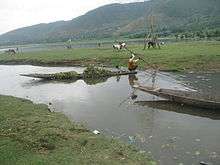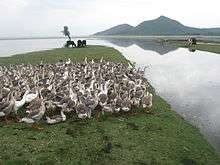Wular Lake
| Wular Lake جھیل ولر | |
|---|---|
 Wular Lake | |
| Location | Jammu and Kashmir, India |
| Coordinates | 34°20′N 74°36′E / 34.333°N 74.600°ECoordinates: 34°20′N 74°36′E / 34.333°N 74.600°E |
| Primary inflows | Jhelum River |
| Primary outflows | Jehlum River |
| Basin countries | Jammu and Kashmir |
| Max. length | 16 km |
| Max. width | 9.6[1] km |
| Surface area | 12 to 100 sq mi (30 to 260 km²) |
| Max. depth | 14 metres |
| Surface elevation | 1,580 m |
| Islands | Zainul Lank |
| Settlements | Bandipore |
| Designated | 23 March 1990 |




Wular Lake (also spelt Wullar) is one of the largest fresh water lakes in Asia. It is sited in Bandipora district in the Indian state of Jammu and Kashmir. The lake basin was formed as a result of tectonic activity and is fed by the Jhelum River. The lake's size varies seasonally from 12 to 100 square miles (30 to 260 square kilometers). In addition, much of the lake has been drained as a result of willow plantations being built on the shore in the 1950s.
Etymology
In ancient times, Wular Lake was also called Mahapadamsar (Sanskrit: महापद्मसरः). Nilamata Purana also mentions it as Mahapadmasaras. Mahapadamsar is referred as Bolor by Al-Biruni {960–1031 AD}. The lake, with its big dimensions and the extent of water, gives rise to high leaping waves in the afternoons, called Ullola in Sanskrit, meaning "stormy leaping, high rising waves". Therefore, it was also being called Ullola. Its corrupted form saw its transition as Bolor by Al-Biruni and over the centuries corrupted further to Wulor or Wular.[2][3] The origin may also be attributed to a Kashmiri word 'Wul', which means a gap or a fissure, appellation that must have come also during this period. The word Wul {Gap or fissure}, is also indicator of its origin to a fissure or gap created.
Natural history
The lake is one of the 26 Indian wetlands designated as a Ramsar site. However it faces environmental threats including the conversion of large parts of the lake's catchment areas into agriculture land, pollution from fertilizers and animal wastes, hunting of waterfowl and migratory birds, and weed infestation in the lake itself.[4]
Fish
Wular Lake is an important fish habitat, the main species being the common carp (Cyprinus carpio), rosy barb (Barbus conchonius), mosquitofish (Gambusia affinis), Nemacheilus species, Crossocheilus latius, and various snowtrout species in the genera Schizopyge and Schizothorax. Snowtrout species identified in the lake include the Sattar snowtrout (Schizopyge curvifrons), Chirruh snowtrout (Schizopyge esocinus), Schizothorax planifrons, Schizothorax macropogon, Schizothorax longipinus and Chush snowtrout (Schizopyge niger).[4]
Fish from Wular Lake make up a significant part of the diet for many thousands of people living on its shores and elsewhere in the Kashmir Valley. More than eight thousand fishermen earn their livelihood from the lake, primarily fishing for the endemic Schizothorax species and the non-native carp. Their catch comprises about 60 percent of the total yield of fish in Kashmir. Hundreds of other local villagers are employed by cooperative societies that trade the fish catch. Many other families harvest plants such as the grass Phragmites and the waterlily-like Nymphoides from the lake for animal fodder.[4]
Birds
The lake sustains a rich population of birds. Terrestrial birds observed around the lake include the black-eared kite, Eurasian sparrowhawk, short-toed eagle, Himalayan golden eagle, Himalayan monal, chukar partridge, koklass pheasant, rock dove, common cuckoo, alpine swift, Indian roller, Himalayan woodpecker, hoopoe, barn swallow, golden oriole and others.[4]
History
The Kashmiri sultan Zain-ul-Abidin is reputed to have ordered the construction of the artificial island of Zaina Lank in the middle of the lake in 1444.[5]
Tulbul Project
The Tulbul Project is a "navigation lock-cum-control structure" at the mouth of Wular Lake. According to the original Indian plan, the barrage was expected to be of 439 feet (134 m) long and 40 feet (12 m) wide, and would have a maximum storage capacity of 300,000 acre feet (370,000,000 m3) of water. One aim was to regulate the release of water from the natural storage in the lake to maintain a minimum draught of 4.5 feet (1.4 m) in the river up to Baramulla during the lean winter months. The project was conceived in the early 1980s and work began in 1984.
There has been an ongoing dispute between India and Pakistan over the Tulbul Project since 1987, when Pakistan objected that it violated the 1960 Indus Waters Treaty. India stopped work on the project that year, but has since pressed to restart construction. The Jhelum River through the Kashmir valley below Wular Lake provides an important means of transport for goods and people. To sustain navigation throughout the year a minimum depth of water is needed. India contends that this makes development of the Tulbul Project permissible under the treaty, while Pakistan maintains that the project is a violation of the treaty. India says suspension of work is harming the interests of people of Jammu and Kashmir and also depriving the people of Pakistan of irrigation and power benefits that may accrue from regulated water releases.
Recognition
In recognition of its biological, hydrological and socio-economic values, the lake was included in 1986 as a Wetland of National Importance under the Wetlands Programme of the Ministry of Environment and Forests, Government of India for intensive conservation and management purposes. Subsequently in 1990, it was designated as a Wetland of International Importance under the Ramsar Convention.[6][1]
Restoration
Amongst other developments, two million trees will be cut to restore Wular Lake under the National Lake Conservation Programme.[7] The Environment Ministry of India approved Rs 4 billion for the restoration project for the lake that will take 5 to 10 years and was after long delays scheduled to start in December 2011.[8] The partner organisation South Asian Voluntary Association of Environmentalists (SAVE) is a joint initiative of individuals with the aim to protect the ecology and to conserve the nature at Wular Lake.[9]
Tourism
Boating, water sports and water skiing have been launched by the Government of India Tourism in collaboration with Kerala Tourism and J&K Tourism. The contract for the operation of the site was awarded in September 2011.
See also
References
| Wikimedia Commons has media related to Wular Lake. |
- 1 2 "Slide 1" (PDF). Retrieved 2012-11-07.
- ↑ Ramsar Sites of India: Wular Lake, Jammu and Kashmir, World Wide Fund for Nature, India, 1994, ... The name "Vulla" from which the present name Wular or Volar (Vulgo Woolar) seems to have been derived, is found in the Janarajas chronicle and can be interpreted as 'turbulent' or the lake with high-going waves' ...
- ↑ Imperial Gazetteer of India, Sir William Wilson Hunter, pp. 387, Clarendon Press, 1908, ... Wular Lake - Lake in Kashmir State ... bad reputation among the boatmen of Kashmir, for when the winds come down the mountain gorges, the quiet surface of the lake changes into a sea of rolling waves ... corruption of ullola, Sanskrit for 'turbulent' ... The ancient name is Mahapadmasaras, derived from the Naga Mahapadma, who is located in the lake as its tutelary deity ...
- 1 2 3 4 "Wular Lake". World Wide Fund for Nature India. Archived from the original on 2 June 2009. Retrieved 17 March 2010.
- ↑ "How to kill a lake". 30 January 2009. Retrieved 17 March 2010.
- ↑ Ramsar Convention
- ↑ "20 lakh trees to be cut to restore Wullar lake". Hindustan Times. 2011-06-02. Retrieved 2012-08-17.
- ↑ GreaterKashmir.com (Greater Service) (2011-11-20). "Wullar Lake to get breather Lastupdate:- Sun, 20 Nov 2011 18:30:00 GMT". Greaterkashmir.com. Retrieved 2012-08-17.
- ↑ "South Asian Voluntary associat... - Organizations - TakingITGlobal". Retrieved 12 November 2016.